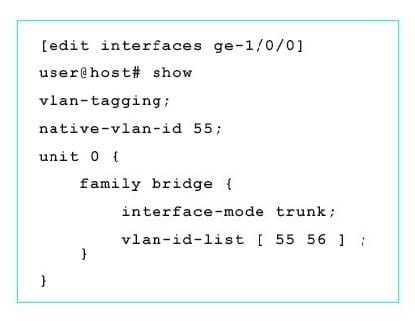Exam Details
Exam Code
:JN0-361Exam Name
:Service Provider Routing and Switching, Specialist (JNCIS-SP)Certification
:Juniper CertificationsVendor
:JuniperTotal Questions
:542 Q&AsLast Updated
:Apr 15, 2025
Juniper Juniper Certifications JN0-361 Questions & Answers
-
Question 211:
Click the Exhibit button.

Which two statements are true regarding the output shown in the exhibit? (Choose two.)
A. The ge-1/0/0 interface will transmit any outgoing frames associated with VLAN 55 as untagged frames.
B. The ge-1/0/0 interface will associate any untagged frames that are received with VLAN 56.
C. The ge-1/0/0 interface will associate any untagged frames that are received with VLAN 55.
D. The ge-1/0/0 interface will transmit any outgoing frames associated with VLAN 56 as untagged frames.
-
Question 212:
An IS-IS TLV includes which two attributes? (Choose two.)
A. topology
B. vector
C. length
D. value
-
Question 213:
An IS-IS router on a broadcast medium has detected its LSDB is missing an LS PDU.
Which action will the router take?
A. The router will send a CSNP to the router that sent it a PSNP with missing PDUs.
B. The router will send a link-state request packet to its closest Level 1/Level2 router.
C. The router will send a PSNP to the router that sent it a CSNP with missing PDUs.
D. The router will send a link-state request packet to its DIS router.
-
Question 214:
How many bytes does IP-IP tunneling add to an IP packet?
A. 20
B. 24
C. 16
D. 28
-
Question 215:
You are adding IPv6 to an existing IPv4 network running OSPF. Your plan is to use OSPFv3 to route both
IPv4 and IPv6 prefixes.
Which configuration will enable OSPFv3 to advertise prefixes for both IPv4 and IPv6?
A. user@host# show protocols ospf3 realm ipv4-unicast { area 0.0.0.0 { interface ge-0/0/0.0; } } area 0.0.0.0 { interface ge-0/0/0.0; }
B. user@host# show protocols ospf3 export ipv4; area 0.0.0.0 { interface ge-0/0/0.0; }
C. user@host# show protocols ospf area 0.0.0.0 { interface ge-0/0/0.0; } user@host# show protocols ospf3 area 0.0.0.0 { interface ge-0/0/0.0; }
D. user@host# show protocols ospf3 rib-group inet.0; area 0.0.0.0 { interface ge-0/0/0.0; }
-
Question 216:
In an RSVP-based MPLS network, which ERO type specifies the exact order of routers through which an LSP must travel, without consulting the IGP?
A. loose hop
B. static hop
C. next hop
D. strict hop
-
Question 217:
What are three well-known mandatory BGP attributes? (Choose three.)
A. origin
B. MED
C. AS path
D. next hop
E. local preference
-
Question 218:
Your customer requests that you provide a transparent Layer 2 service between two of their remote locations. This service must allow the customer to pass tagged traffic from multiple VLANs. You decide to use Q-in-Q tunneling on the two provider edge MX Series routers that connect to the customer's CE devices.
Which two statements are true? (Choose two.)
A. As traffic enters the Q-in-Q tunnel on the core-facing interface on the ingress PE device, a push operation is performed.
B. As traffic passes through intermediary P routers in the Q-in-Q tunnel, a push operation is performed.
C. As traffic passes through intermediary P routers in the Q-in-Q tunnel, a swap operation is performed.
D. As traffic enters the Q-in-Q tunnel on the core-facing interface on the ingress PE device, a swap operation is performed.
-
Question 219:
Click the Exhibit button.

Referring to the exhibit, which two statements are correct? (Choose two.)
A. Type 2 LSAs are not created for this link.
B. Type 2 LSAs are created for this link.
C. Designated router election does not occur on this link.
D. Designated router election occurs on this link.
-
Question 220:
What are three IS-IS PDU types? (Choose three.)
A. type length value
B. link-state
C. partial sequence number
D. database description
E. complete sequence number
Related Exams:
JN0-102
Internet Associate, Junos(JNCIA-Junos)JN0-104
Junos, Associate (JNCIA-Junos)JN0-105
Junos, Associate (JNCIA-Junos)JN0-1101
Juniper Networks Certified Design Associate (JNCDA)JN0-130
Juniper networks Certified internet specialist.e(jncis-e)JN0-1301
Data Center Design, Specialist (JNCDS-DC)JN0-1302
Data Center Design Specialist (JNCDS-DC)JN0-1331
Security Design, Specialist (JNCDS-SEC)JN0-1332
Security Design, Specialist (JNCDS-SEC)JN0-1361
Service Provider Design Specialist (JNCDS-SP)
Tips on How to Prepare for the Exams
Nowadays, the certification exams become more and more important and required by more and more enterprises when applying for a job. But how to prepare for the exam effectively? How to prepare for the exam in a short time with less efforts? How to get a ideal result and how to find the most reliable resources? Here on Vcedump.com, you will find all the answers. Vcedump.com provide not only Juniper exam questions, answers and explanations but also complete assistance on your exam preparation and certification application. If you are confused on your JN0-361 exam preparations and Juniper certification application, do not hesitate to visit our Vcedump.com to find your solutions here.